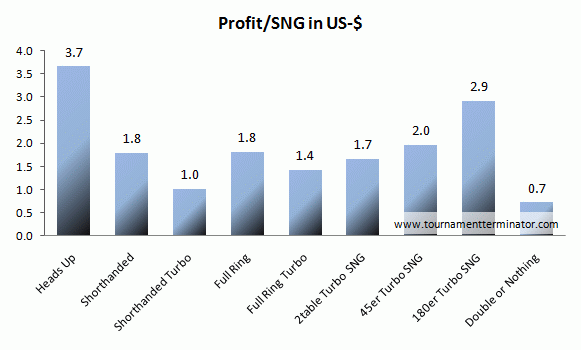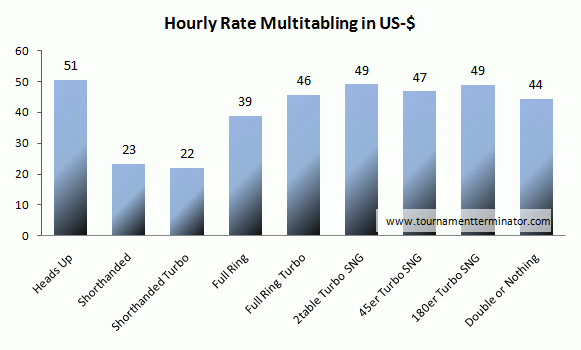Recommended Poker Room
Sit and Go’s are available in many varieties. The most frequently played variants of SNG’s are:
- Heads Up
- Shorthanded
- Shorthanded Turbo
- Full Ring
- Full Ring Turbo
- 2table Turbo SNG
- 45er Turbo SNG
- 180er Turbo SNG
- Double or Nothing
With which of these variants of Sit and Go’s can you earn the most? Which is thus the best SNG poker game? We have made an attempt to estimate the potential profit per variant. Significant to this is the hourly generated by the best players in the corresponding variant. The ROI or the profit per game are not decisive. It is important that the hourly rate is as high as possible. This hourly rate is composed of the profit per game, the duration of the tournament and the number of tables that can be played simultaneously.
Earnings per SNG
We have taken into account in each case the best three players of the current year according to the Sharkscope leaderboards, playing at PokerStars with buy-ins between $ 5.01 and $ 15.00. We have assumed that a player who is on top of the global rankings in a SNG variant is only playing this version of Texas Hold’em tournaments. Based on the data from Sharkscope, we have collected the number games and the sum of the profits of the top three players for each variant. We have then used these figures to calculate the average profit per SNG. Of course, earnings per SNG is just one of three decisive factors of the hourly wage of a tournament player. We also considered the duration of a SNG tournament and the capacity to play each kind of tournament on multiple tables (multitabling capacity).
Duration of a SNG
The second factor is the duration of a Sit and Go tournament. Turbo SNG’s take significantly less time to finish per tournament than regular SNG’s with normal blind levels. Thus, if the profits per SNG both in turbo and in regular Sit’n Go’s were the same, the turbos would be considerably more profitable, because you can play more of them per hour.
Multitabling Capacity: Number of Tables
The third key factor which determines the hourly wage of a SNG player is the multitabling capability. The fewer opponents are at the table, the fewer tables can be played simultaneously. In a heads-up SNG you play only against one opponent, you must therefore perform actions much more often than in a 180-man SNG where you sit for long stretches of the tournament at a full table.
For these two points we had to make assumptions. In particular the question of how many tables a regular poker player can play simultaneously can be only estimated.
The assumptions for the duration of the each tournament variant and the capability to multitable are:
| SNG Variant | Time/SNG (Min) | # Tables Multitabling |
| Heads Up | 13 | 3 |
| Shorthanded | 33 | 7 |
| Shorthanded Turbo | 20 | 7 |
| Full Ring | 39 | 14 |
| Full Ring Turbo | 26 | 14 |
| 2table Turbo SNG | 33 | 16 |
| 45er Turbo SNG | 46 | 18 |
| 180er Turbo SNG | 72 | 20 |
| Double or Nothing | 20 | 20 |
Earnings per SNG Poker Game
For our analysis we have used the Sharkscope stats of the following PokerStars SNG players holding top positions in the leaderboards for the various tournament variants:
- Heads-Up: cowboymarco, lilachaa, R.Graholsky
- Shorthanded: Epimp101, Truck T, TrueGrinder
- Shorthanded Turbo: cmonk33, zaharka, premo321
- Full Ring: riverkila, eb581, schex.on
- Full Ring Turbo: abarone68, Envision9, sippin_criss
- 2table Turbo SNG: jcar9271, sevenyrold, roachclips
- 45er Turbo SNG: Dawgs678, Reb3186, SanJoShark
- 180er Turbo SNG: ihaterivers, PortlyPig, pokerguru69
- Double or Nothing: Shortyx, Dewster11, kikoz1
As the following graphic shows, the earnings per SNG in Heads-Up and in the 180-man SNG’s are the highest:

Taking into account that the tournament variations have different game lengths and that a very good player can play different numbers of tables simultaneously, we estimate the following hourly rate for for these SNG variations with an average buy-in of $ 10:

As you can see, with the exception of the short-handed tables these top regular players earn hourly rates in the $ 5-15 buy-in Sit and Go’s between $ 40 and $ 50. There are for sure SNG grinders with even higher hourly rates, but they are not included in this analysis because they did not play that many tournaments in this year. We estimate that in the long term an hourly wage of $ 75 at these limits is achievable for very good players. In addition, there are certainly players who play poker at higher levels and achieve an even higher hourly wage.
Tip: If you want to play at PokerStars (U.S. players welcome), the largest poker room in the world, then open up an account now through this link. Use the PokerStars marketing code “psp13368“ when you register. This will enable you to grab the maximum bonus of $ 600!


 www.
www.
Hello,
Interesting article.
However, in the one area I feel comfortable commenting on, I believe there is a major inaccuracy.
Cowboymarco, your heads up example, plays a certain speed of heads up sngs that are called “no blind increase.” In these, players start with full stacks and the blinds never increase. This results in long game averages (well over 30 minutes per game from what players in them tell me).
Further (you can find threads on the 2p2 and HUSNG forums about this), players in this specific structure often are the benefactors of players accidentally signing up for this structure and not realizing that the blinds never increase. “Pros” of this structure often take advantage of the player’s mistake even further by taking a lot of time to act on every decision, thereby slowing the game down even more. PokerStars tolerates this at the time of writing, though they have said steps may be taken in the future.
What does this all mean? This is no insult to CowboyMarco or any other no blind increase player, it is meant to point out that the average length of these games is not 13 minutes (Stars turbo is closer to 8-12 minutes per match depending on the buyin, usually the lower the buyin the faster the avg match time for turbos), but over 30 minutes.
If what I read was comprehended correctly, this would vastly weaken your hourly estimates for the heads up portion of the graph.
However, there are other heads up players that earn a greater hourly than CowboyMarco. To fully calculate this is no easy task though. Certain levels of games (not limited to heads up sng) take much longer to actually get an opponent in than others. If you sit at the computer for an hour in a no blind increase match before you have an opponent, then play an hour match, can you really dismiss the hour you sat there at your computer waiting for that match? Wait times are most common in slower structures and slower structures usually offer the highest possible edge per game. Higher buyin games also tend to take longer to fill on average. This all means that there are a ton of variables that are necessary to accurately estimate the hourly of a heads up sng player, even one specific player.
Let me know if you have any questions about my commentary. Thank you.
Great comment, thank you Ryan for your points.
As with all poker related theories, “it depends”. These figures are just gross estimates, for example, I was not aware that cowboymarco is playing no blind increase SNG’s. I just had to rely on the gross data I could gather from Sharkscope.
Of course you are right, a longer playing time per game will decrease the hourly rate.
The waiting time is another imporatant factor, you are right there. That’s why I took PokerStars as an example, as that poker site has the most traffic (and therefore the lowest waiting times). But still, if you can play a maximum of 12 tables, the real average will be 6, 8 or 10 tables. So assume that the mulittabling figures shown per game are the effective averages (and not the theoretical maximum one can play).
Again, thanks for your comment!